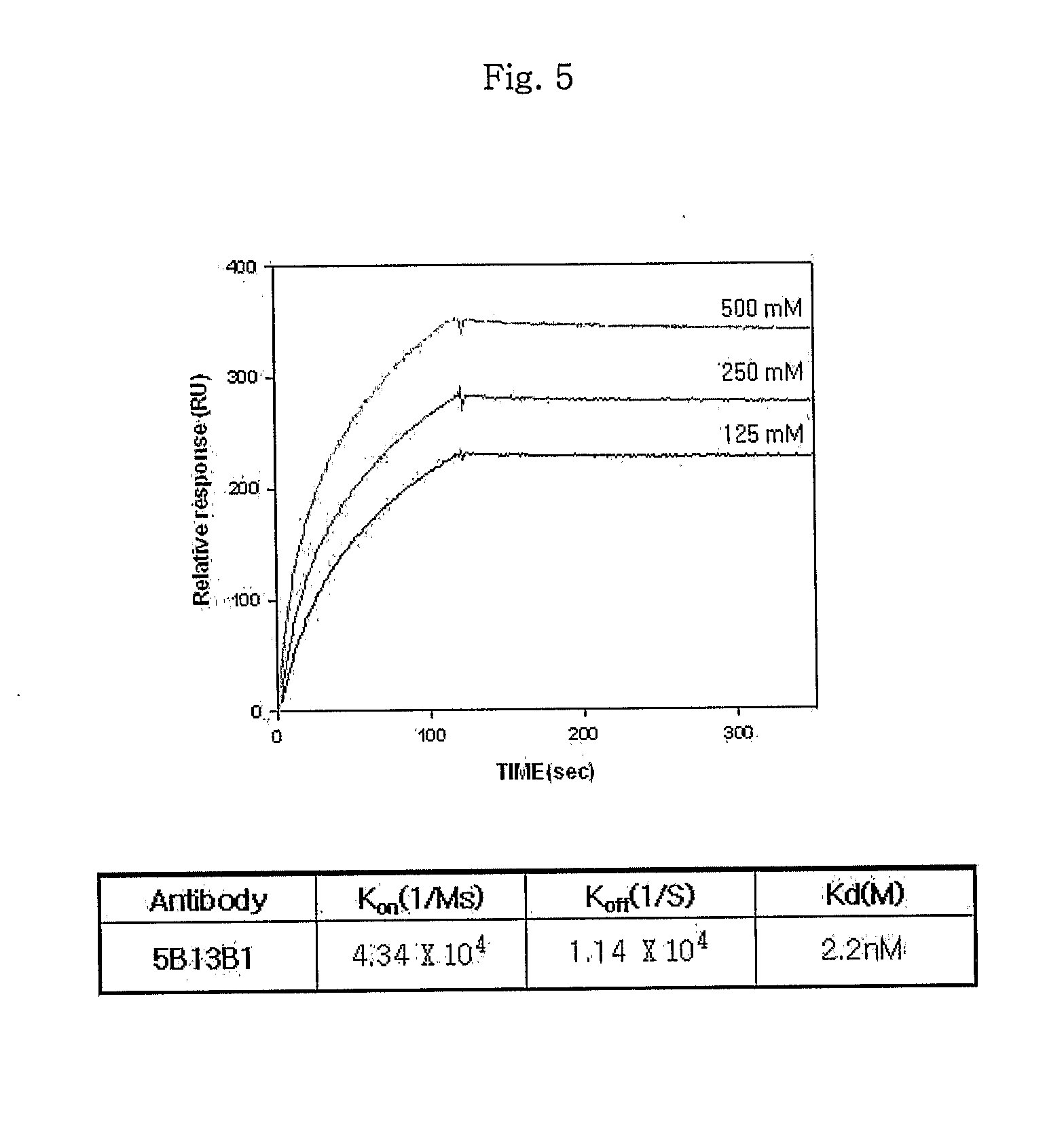Monoclonal antibody specific to anthrax toxin
a monoclonal antibody and anthrax technology, applied in the field of monoclonal antibodies, can solve the problems of inactive study of anthrax, most lethal inhalation infection, and deterioration of symptoms, so as to prevent or treat anthrax
- Summary
- Abstract
- Description
- Claims
- Application Information
AI Technical Summary
Benefits of technology
Problems solved by technology
Method used
Image
Examples
example 1
Preparation and Production of Toxin Antigens
1. Construction of Plasmids Expressing Toxin Antigens
[0113]The Bacillus anthracis pXO1 plasmid carrying the genes coding for protective antigen and lethal factor and a pT7-PA plasmid carrying the protective antigen gene were obtained from the Pathogen Control Laboratory, the Korean Center for Disease Control and Prevention. The protective antigen gene was excised from the pT7-PA plasmid by digestion with BamHI and SalI, and inserted into a pBS1-1 vector, thus yielding an expression vector. Separately, the lethal factor gene was amplified by polymerase chain reaction (PCR) using the B. anthracis pXO1 plasmid as a template with a pair of primers, represented by SEQ ID Nos. 11 and 12, and cloned into pBS1-1 containing an S1-tag, which was obtained from Aprogen Inc., Korea (Meesook et al., J Immunol Methods. 2003 December; 283(1-2):77-89) (FIG. 1).
(SEQ ID No. 11)5′-primer: 5′-cgtggatccatggcgggcggtcatggtgatg-3′(SEQ ID No. 12)3′-primer: 5′-gattc...
example 2
Establishment of Mouse Hybridomas
[0116]1. Mouse Immunization with Protective Antigen of Bacillus anthracis
[0117]Balb / c mice were immunized with the purified lethal factor of B. anthracis by subcutaneous injection. Mice were immunized first with 20 μg of the lethal factor emulsified in complete Freund's adjuvant, and were then immunized with 20 μg of the lethal factor emulsified in incomplete Freund's adjuvant three times more, once every two weeks. After two weeks, the lethal factor was diluted with phosphate buffer and intravenously injected into mice.
2. Evaluation of Polyclonal Antibodies in sera for Anthrax-Neutralizing Activity After Immunization Injection
[0118]After the second immunization, blood samples were collected from orbital venous plexus of mice, and isolated sera were assessed for anthrax toxin-neutralizing activity. A neutralization assay was carried out using a mouse macrophage cell line, J774A.1. 4×104 J774A.1 Cells were seeded onto a 96-well cell culture plate, an...
example 3
Evaluation of Toxin-Neutralizing Activity of the Monoclonal Antibodies
1. Evaluation of Antigen Binding Ability of the Monoclonal Antibodies
[0124]The selected monoclonal antibodies were evaluated for antigen binding activity using surface plasmon resonance with a BiaCoreX instrument. The expressed lethal factor was immobilized onto a CM5 chip and reacted with serial dilutions of the antibody. As a result, the 5B13B1 antibody was found to have a Kon value of 4.34×104 M−1S−1 and a Koff of 1.14×10−4S−1. From these Kon and Koff values, a Kd of 2.2 nM was calculated, indicating that the 5B13B1 antibody has a high affinity to its antigen (FIG. 5).
2. Evaluation of Toxin-Neutralizing Activity at the Cell Level
[0125]The two selected monoclonal antibodies against lethal factor were serially diluted and analyzed for anthrax toxin-neutralizing activity using a mouse macrophage cell line, J774A.1. Each antibody was serially diluted, reacted with anthrax toxin at 4° C. for 30 min, and applied to t...
PUM
| Property | Measurement | Unit |
|---|---|---|
| length | aaaaa | aaaaa |
| pH | aaaaa | aaaaa |
| concentrations | aaaaa | aaaaa |
Abstract
Description
Claims
Application Information
 Login to View More
Login to View More - R&D
- Intellectual Property
- Life Sciences
- Materials
- Tech Scout
- Unparalleled Data Quality
- Higher Quality Content
- 60% Fewer Hallucinations
Browse by: Latest US Patents, China's latest patents, Technical Efficacy Thesaurus, Application Domain, Technology Topic, Popular Technical Reports.
© 2025 PatSnap. All rights reserved.Legal|Privacy policy|Modern Slavery Act Transparency Statement|Sitemap|About US| Contact US: help@patsnap.com



